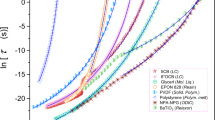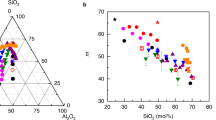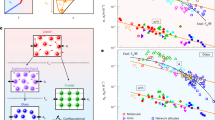Abstract
If crystallization can be avoided when a liquid is cooled, it will typically form a glass. Near the glass transition temperature the viscosity increases continuously but rapidly with cooling. As the glass forms, the molecular relaxation time increases with an Arrhenius-like (simple activated) form in some liquids, but shows highly non-Arrhenius behaviour in others. The former are said to be ‘strong’ liquids, and the latter ‘fragile’1,2. Here we show that the fragility of a liquid can be determined from purely thermodynamic data (as opposed to measurements of kinetics) near and below the melting point. We find that for most liquids the fragilities estimated this way are consistent with those obtained by previous methods and by a new method (ref. 3 and K.I., C.A.A. and C.T.M., unpublished data) at temperatures near the glass transition. But water is an exception. The thermodynamic method indicates that near its melting point it is the most fragile of all liquids studied, whereas the kinetic approach indicates that near the glass transition it is the least fragile. We propose that this discrepancy can be explained by a fragile-to-strong transition in supercooled water near 228 K, corresponding to a change in the liquid's structure at this point.
This is a preview of subscription content, access via your institution
Access options
Subscribe to this journal
Receive 51 print issues and online access
$199.00 per year
only $3.90 per issue
Buy this article
- Purchase on Springer Link
- Instant access to full article PDF
Prices may be subject to local taxes which are calculated during checkout


Similar content being viewed by others
References
Angell, C. A. Relaxation in liquids, polymers and plastic crystals—strong/fragile patterns and problems. J. Non-Cryst. Solids 131–133 , 13–31 (1991).
Angell, C. A. Formation of glasses from liquids and biopolymers. Science 267, 1924–1935 (1995).
Moynihan, C. T. Correlation between the width of the glass transition and the temperature dependence of the viscosity in high Tgglasses. J. Am. Ceram. Soc. 76, 1081–1087 (1993).
Kauzmann, W. The nature of the glassy state and the behavior of liquids at low temperatures. Chem. Rev. 43, 219–256 (1948).
Angell, C. A. & Tucker, J. C. Heat capacities and fusion entropies of the tetrahydrates of calcium nitrate, cadmium nitrate, and magnesium acetate. Concordance of calorimetric and relaxational ‘ideal’ glass transition temperatures. J. Phys. Chem. 78, 278– 281 (1974).
Xu, Y. & Heppler, L. Calorimetric investigations of crystalline, molten, and supercooled Ca(NO3)2·4H2O and of concentrated Ca(NO3)2(aq). J. Chem. Thermodyn. 25, 91–97 ( 1993).
Angell, C. A. et al. Liquid fragility and the glass transition in water and aqueous solutions. Int. J. Food Sci. 22, 115– 142 (1994).
Takahara, S., Yamamuro, O. & Matsuo, T. Calorimetric study of 3-bromopentane: correlation between structural relaxation time and configurational entropy. J. Phys. Chem. 99, 9589–9592 ( 1995).
Richert, R. & Angell, C. A. Dynamics of glassforming liquids. IV: On the link between molecular dynamics and configurational entropy. J. Chem. Phys. 108, 9016–9026 (1998).
Chang, S. S. & Bestul, A. b. Heat capacities of selenium crystal (trigonal), glass, and liquid from 5 to 360 K. J. Chem. Thermodyn. 6, 325–344 ( 1974).
Gibbs, J. H. in Modern Aspects of the Vitreous State(ed. McKenzie, J. D.) Ch. 7 (Butterworths, London, (1960).
Goldstein, M. Viscous liquids and the glass transition. IV. Thermodynamic equations and the transition. J. Phys. Chem. 77, 667– 673 (1973).
Sastry, S., Debenedetti, P. G. & Stillinger, F. H. Signatures of distinct dynamical regimes in the energy landscape of a glass-forming liquid. Nature 393, 554–557 (1998).
Angell, C. A., Shuppert, J. & Tucker, J. C. Anomalous properties of supercooled water: heat capacity, expansivity, and PMR chemical shift from 0 to −38 °C. J. Phys. Chem. 77, 3092–3099 (1973).
Donth, E. The size of cooperative rearranging region at the glass transition. J. Non-Cryst. Solids 53, 325–330 (1982).
Hodge, I. M. Comment on the fragility of liquids—a brief critique. J. Non-Cryst. Solids 202, 164–172 (1997).
Angell, C. A. Simple glassformers: their definition, fragilities and landscape excitation profiles. J. Phys., Cond. Matter 11, 75– 94 (1999).
Angell, C. A. & Sare, E. J. Glass-forming composition regions and glass transition temperatures for aqueous electrolyte solutions. J. Chem. Phys. 52, 1058–1068 (1970).
Angell, C. A. & Tucker, J. C. Heat capacity changes in glass-forming aqueous solutions, and the glass transition in vitreous water. J. Phys. Chem. 84, 268–272 (1980).
Johari, G., Hallbrucker, A. & Mayer, E. The glass-liquid transition of hyperquenched water. Nature 330, 552–553 (1987).
Hallbrucker, A., Mayer, E. & Johari, G. P. Glass-liquid transition and the enthalpy of devitrification of annealed vapor-deposited amorphous water. A comparison with hyperquenched glassy water. J. Phys. Chem. 93, 4986– 4990 (1989).
Angell, C. A., Clarke, J. H. R. & Woodcock, L. V. Interaction potentials and glass formation: A survey of computer experiments. Adv. Chem. Phys. 48, 397–453 (1981).
Hofer, K., Mayer, E. & Johari, G. P. Glass-liquid transition of water and ethylene glycol solution in poly(2-hydroxyethyl methacrylate) hydrogel. J. Phys. Chem. 94, 2689–2696 ( 1990).
Speedy, R. J. & Angell, C. A. Isothermal compressibility of supercooled water and evidence for a thermodynamic singularity at 45 °C. J. Chem. Phys. 65, 851– 858 (1976).
Sastry, S., Debenedetti, P. G., Sciortino, F. & Stanley, H. E. Singularity-free interpretation of the thermodynamics of supercooled water. Phys. Rev. E 53, 6144– 6154 (1996).
Thompson, M. O., Galvin, G. J. & Mayer, J. W. Melting temperatures and explosive crystallization of amorphous silicon during pulsed laser irradiation. Phys. Rev. Lett. 52, 2360–2363 ( 1984).
Angell, C. A. & Borick, S. Comment on “Structure of Supercooled Liquid Silicon” by Ansell et al. J. Phys., Cond. Matter (in the press).
Brückner, R. Metastable equilibrium density of hydroxyl-free synthetic vitreous silica. J. Non-Cryst. Solids 5, 281– 285 (1971).
Rebelo, L. P. N., Debenedetti, P. G. & Sastry, S. Singularity-free interpretation of the thermodynamics of supercooled water. II. Thermal and volumetric behavior. J. Chem. Phys. 109, 626–633 ( 1998).
Starr, F., Angell, C. A., Speedy, R. J. & Stanley, H. E. Entropy and dynamic properties of water at 1 atm in the “experimentally-inaccessible” region between 150K and 236K Phys. Rev. Lett. (submitted).
Adam, G. & Gibbs, J. H. On the temperature dependence of cooperative relaxation properties in glass-forming liquids. J. Chem. Phys. 43, 139–146 (1965).
Angell, C. A. Entropy and fragility in supercooling liquids. J. Res. NIST 102, 171–185 (1997).
Angell, C. A., Finch, E. D., Woolf, L. A. & Bach, P. Spin-echo diffusion coefficients of water to 2380 bar and −20 °C. J. Chem. Phys. 65, 3063– 3066 (1976).
Allegra, J. C., Stein, A. & Allen, G. F. Tracer diffusion and shear viscosity for the system isobutyric acid-water near the critical mixing point. J. Chem. Phys. 55, 1716–1720 ( 1971).
Smith, R. S., Huang, C. & Kay, B. D. Evidence for molecular translational diffusion, during the crystallization of amorphous solid water. J. Phys. Chem. B 101, 6123–6126 ( 1997).
Smith, R. S. & Kay, B. D. Evidence for the existence of supercooled liquid water at 150 K. Nature 398(in the press)
Roberts, C. J., Karayiannekis, C. & Debenedetti, P. G. Liquid-liquid immiscibility in single-component network-forming fluids: Model calculations and implications for polyamorphism in water. Ind. Eng. Chem. Res. 37, 3012–3022 (1998).
Acknowledgements
This work was supported by the NSF DMR Solid State Chemistry program.
Author information
Authors and Affiliations
Corresponding author
Rights and permissions
About this article
Cite this article
Ito, K., Moynihan, C. & Angell, C. Thermodynamic determination of fragility in liquids and a fragile-to-strong liquid transition in water. Nature 398, 492–495 (1999). https://doi.org/10.1038/19042
Received:
Accepted:
Issue Date:
DOI: https://doi.org/10.1038/19042
This article is cited by
-
Structural Relaxation and Thermodynamics of Viscous Aqueous Systems: A Simplified Reappraisal
Journal of Solution Chemistry (2023)
-
Entropy-driven atomic activation in supercooled liquids and its link to the fragile-to-strong transition
Science China Physics, Mechanics & Astronomy (2023)
-
Pressure-induced liquid-liquid transition in a family of ionic materials
Nature Communications (2022)
-
Influence of the interatomic repulsive hardness on the microstructure and dynamics of CuZr metallic glasses
Journal of Molecular Modeling (2022)
-
Structure Transformations and Supercooling in Nanostructured Gallium Alloys
Applied Magnetic Resonance (2022)
Comments
By submitting a comment you agree to abide by our Terms and Community Guidelines. If you find something abusive or that does not comply with our terms or guidelines please flag it as inappropriate.



